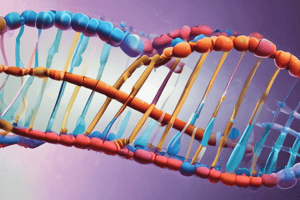Podcast
Questions and Answers
What is the first major step in DNA replication?
What is the first major step in DNA replication?
- Breaking of hydrogen bonds between bases (correct)
- Elongation of daughter strands
- Termination of replication
- Binding of RNA Primase
What enzyme is responsible for splitting the two strands of DNA?
What enzyme is responsible for splitting the two strands of DNA?
- DNA Polymerase
- RNA Primase
- Helicase (correct)
- DNA Ligase
What do we call the structure created during the unwinding of DNA?
What do we call the structure created during the unwinding of DNA?
- Telomere
- Okazaki Fragment
- Leading Strand
- Replication Fork (correct)
What is the role of RNA Primase in DNA replication?
What is the role of RNA Primase in DNA replication?
What is the difference between the leading and lagging strands during elongation?
What is the difference between the leading and lagging strands during elongation?
What are Okazaki fragments?
What are Okazaki fragments?
The action of DNA Pol I is to add nucleotides to the gaps in the lagging strand.
The action of DNA Pol I is to add nucleotides to the gaps in the lagging strand.
What is semiconservative replication?
What is semiconservative replication?
What happens during the termination step of DNA replication?
What happens during the termination step of DNA replication?
Flashcards are hidden until you start studying
Study Notes
Step 1: Unwinding of DNA
- Hydrogen bonds between bases of antiparallel strands break, initiating the DNA replication process.
- The unwinding occurs predominantly at regions rich in Adenine-Thymine (A-T) due to their two hydrogen bonds compared to the three between Cytosine-Guanine (C-G).
- Helicase enzyme facilitates the separation of strands, establishing the "origin of replication."
- The structure formed during this process is referred to as the "Replication Fork."
Step 2: Priming the Template
- RNA Primase binds to the initiation point of the 3'-5' parent chain, crucial for DNA replication.
- This enzyme attracts RNA nucleotides, which pair with the DNA nucleotides of the 3'-5' strand, forming RNA primers essential for replication.
Step 3: DNA Strand Elongation
- Elongation differs between the leading and lagging strands:
- Leading Strand: Synthesized continuously by DNA Polymerase reading the 5'-3' template, adding complementary nucleotides.
- Lagging Strand: Discontinuous synthesis occurs because DNA Polymerase cannot read the 3'-5' template directly. It uses multiple RNA primers to create short segments known as "Okazaki Fragments."
- The RNA Primers are critical for DNA Polymerase to attach nucleotides to the 3' end, allowing the daughter strand to elongate.
Step 4: Removing RNA Primers
- On the lagging strand, DNA Polymerase I acts as an exonuclease, removing RNA Primers from Okazaki Fragments.
- DNA Polymerase fills the gaps with complementary nucleotides, while DNA Ligase seals the phosphate-sugar backbone.
- Each new double helix retains one old and one new strand; this mechanism is termed semiconservative replication.
Step 5: Termination of Replication
- Termination occurs when DNA Polymerase reaches the end of the strands and cannot seal gaps left after removing RNA primers.
- The ends of linear DNA strands, where the last primer is positioned, are not replicated, leaving noncoding DNA, or telomeres, which consist of repetitive sequences.
- Each replication cycle results in the loss of part of the telomere, which plays a role in cellular aging.
Studying That Suits You
Use AI to generate personalized quizzes and flashcards to suit your learning preferences.




